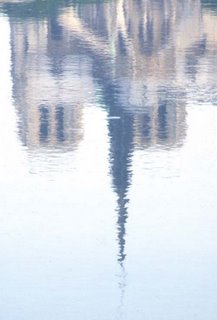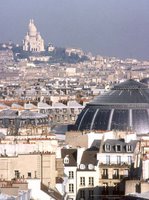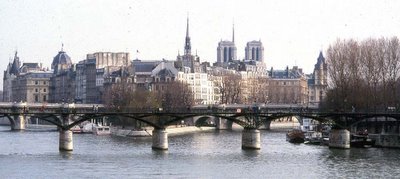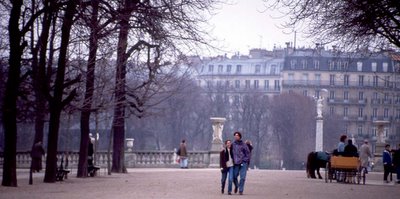Paris was a favorite subject of mine as a student in both the undergraduate architecture and graduate city planning programs at the University of California at Berkeley. In 2004, Andy
 asked me to contribute to his site by developing a few walking tours of Paris that might be of interest to city planners around the world. I’ve written four tours to date and I’m pleased that Andy published them. Two remain to be written and, happily, Andy is not in a hurry.
asked me to contribute to his site by developing a few walking tours of Paris that might be of interest to city planners around the world. I’ve written four tours to date and I’m pleased that Andy published them. Two remain to be written and, happily, Andy is not in a hurry. After this introduction, I will post each individual tour here at about weekly intervals. The photographs on these pages are my own, taken over the past 20 years; most have been digitized from the original color slides. They don’t appear on the Planners Network web site. As always, click on a photo to see a larger version.
The first time I saw Paris was in 1981 when I arrived for a two-semester college language program. In those nine months I think I learned more about the city than I did about the language. Getting around was easy, whether by métro or on foot, and the variety of people, the incredible food on display everywhere, the profusion of public spaces filled with all manner of people, the art, the architecture, even the weather, overwhelmed my senses every day. I suppose I got used to this sensory overload in a way that allowed me to go to class every day and otherwise function on a regular schedule, but I don’t really think it’s possible for someone like me, not born and raised in Paris, to ever really get used to it.
I didn’t get the chance to return again until 1988, but since then I’ve been back at least once a year until 2003, when I moved to France permanently. No one person can communicate all that is Paris. It is so many things on so many levels. These tours are only a beginning.
PARIS: Introduction
The capital and largest city in France, Paris conjures images of romance, literature, gastronomy, art and architecture. Add to that a bit of palace intrigue, revolution, student rebellion, a strong labor movement and a wild political scene, and you have the ingredients for one of the most dynamic, and yet tradition-rich, cities in the world.
Paris has been evolving and re-inventing itself for more than two millennia. Early Gallic tribes in the centuries before the Roman invasion settled on what is now the Ile de la Cité and
 commanded river trade in the region. The Romans arrived in the first century, B.C., and expanded the settlement to the river’s left bank, to the area now known as the Latin Quarter. In the middle ages, as the Roman influence waned, the city re-grouped on the island before once again expanding to both banks of the Seine.
commanded river trade in the region. The Romans arrived in the first century, B.C., and expanded the settlement to the river’s left bank, to the area now known as the Latin Quarter. In the middle ages, as the Roman influence waned, the city re-grouped on the island before once again expanding to both banks of the Seine.The 19th century saw great changes to the original fabric of the city as the famed Baron Haussmann cut wide boulevards through the tangled medieval web of streets. Having been spared destruction during WWII, Paris grew and evolved into the 21st century metropolis it is today.
The city’s great east-west axis extended outward to the modern skyscraper city of La Défense; socialist president François Mitterrand implemented decades-long modernization plans for the entire eastern sector of the city; the very center of Paris underwent a monumental urban renewal that continues today.
The City of Light (so named for the 18th century intellectual movement known as the Enlightenment) is full of examples of planning successes and failures. Seek them out and make up your own mind. The city’s roots run deep in religious, social, and political traditions, yet its citizens are not afraid to move their city ahead in bold new directions.
Paris is large and densely populated, so don’t try to see too much of it at once. Be sure that you have a good guide book or two. Many excellent guides are available in your local bookstores. Whichever one(s) you decide on, be sure it’s not too big or heavy to carry with you on your walks. Look for one with easy-to-read maps and some historical/architectural explanations; illustrations or photos really help you to get your bearings.
There are many tour operators that offer bus tours to the city’s main attractions; these can give you a fine overview of the place and most have on-off privileges (Paris L’OpenTour is just one example). Boat tours along the Seine can be quite crowded but can offer a unique perspective of the city (the largest operator is the Compagnie des Bateaux-Mouches).
However, the best way to see Paris is on foot. Pick a neighborhood and wander around. Don’t worry about getting lost; take frequent turns down small streets. Browse shop windows. Find an outdoor food market and watch what people buy. When you tire, sit down in a café and write postcards, make a journal entry, or just enjoy watching people. Remember that wherever you
 are in the city, a métro stop is not far away; you can always hop a train or a bus to get back to your place of origin.
are in the city, a métro stop is not far away; you can always hop a train or a bus to get back to your place of origin.
The following tours are not comprehensive; they are starting points for discovering Paris on your own. There are very few paths in Paris that haven’t been trodden by countless visitors. Don’t obsess about seeing the “real” Paris. It’s all very real, from the finest museum collections to the kitschiest tourist traps, from the romantic out-of-the-way restaurants to the worn-down greasy spoons, from the meticulously maintained parks to the seedy red light districts; Paris has it all and then some. Bonne promenade!
 Cheese shop on the rue Montorgueil.
Cheese shop on the rue Montorgueil.







I must not know how to navigate this. I'm looking for that photo of the Brasserie and the jazz band on the bridge. WAAAaaaa!
ReplyDelete